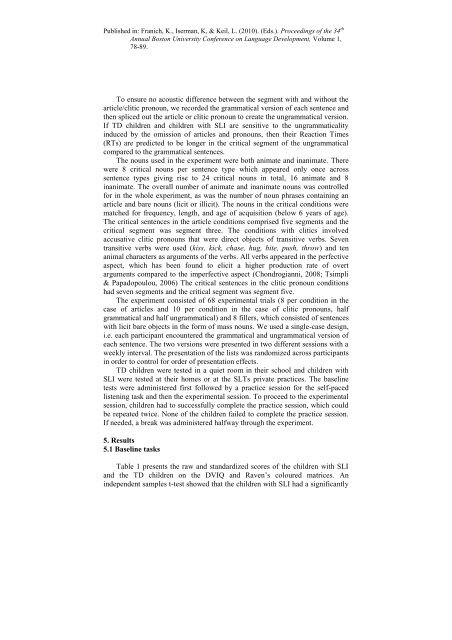On-line Processing of Articles and Clitic Pronouns by Greek ...
On-line Processing of Articles and Clitic Pronouns by Greek ...
On-line Processing of Articles and Clitic Pronouns by Greek ...
Create successful ePaper yourself
Turn your PDF publications into a flip-book with our unique Google optimized e-Paper software.
Published in: Franich, K., Iserman, K, & Keil, L. (2010). (Eds.). Proceedings <strong>of</strong> the 34 th<br />
Annual Boston University Conference on Language Development, Volume 1,<br />
78-89.<br />
To ensure no acoustic difference between the segment with <strong>and</strong> without the<br />
article/clitic pronoun, we recorded the grammatical version <strong>of</strong> each sentence <strong>and</strong><br />
then spliced out the article or clitic pronoun to create the ungrammatical version.<br />
If TD children <strong>and</strong> children with SLI are sensitive to the ungrammaticality<br />
induced <strong>by</strong> the omission <strong>of</strong> articles <strong>and</strong> pronouns, then their Reaction Times<br />
(RTs) are predicted to be longer in the critical segment <strong>of</strong> the ungrammatical<br />
compared to the grammatical sentences.<br />
The nouns used in the experiment were both animate <strong>and</strong> inanimate. There<br />
were 8 critical nouns per sentence type which appeared only once across<br />
sentence types giving rise to 24 critical nouns in total, 16 animate <strong>and</strong> 8<br />
inanimate. The overall number <strong>of</strong> animate <strong>and</strong> inanimate nouns was controlled<br />
for in the whole experiment, as was the number <strong>of</strong> noun phrases containing an<br />
article <strong>and</strong> bare nouns (licit or illicit). The nouns in the critical conditions were<br />
matched for frequency, length, <strong>and</strong> age <strong>of</strong> acquisition (below 6 years <strong>of</strong> age).<br />
The critical sentences in the article conditions comprised five segments <strong>and</strong> the<br />
critical segment was segment three. The conditions with clitics involved<br />
accusative clitic pronouns that were direct objects <strong>of</strong> transitive verbs. Seven<br />
transitive verbs were used (kiss, kick, chase, hug, bite, push, throw) <strong>and</strong> ten<br />
animal characters as arguments <strong>of</strong> the verbs. All verbs appeared in the perfective<br />
aspect, which has been found to elicit a higher production rate <strong>of</strong> overt<br />
arguments compared to the imperfective aspect (Chondrogianni, 2008; Tsimpli<br />
& Papadopoulou, 2006) The critical sentences in the clitic pronoun conditions<br />
had seven segments <strong>and</strong> the critical segment was segment five.<br />
The experiment consisted <strong>of</strong> 68 experimental trials (8 per condition in the<br />
case <strong>of</strong> articles <strong>and</strong> 10 per condition in the case <strong>of</strong> clitic pronouns, half<br />
grammatical <strong>and</strong> half ungrammatical) <strong>and</strong> 8 fillers, which consisted <strong>of</strong> sentences<br />
with licit bare objects in the form <strong>of</strong> mass nouns. We used a single-case design,<br />
i.e. each participant encountered the grammatical <strong>and</strong> ungrammatical version <strong>of</strong><br />
each sentence. The two versions were presented in two different sessions with a<br />
weekly interval. The presentation <strong>of</strong> the lists was r<strong>and</strong>omized across participants<br />
in order to control for order <strong>of</strong> presentation effects.<br />
TD children were tested in a quiet room in their school <strong>and</strong> children with<br />
SLI were tested at their homes or at the SLTs private practices. The base<strong>line</strong><br />
tests were administered first followed <strong>by</strong> a practice session for the self-paced<br />
listening task <strong>and</strong> then the experimental session. To proceed to the experimental<br />
session, children had to successfully complete the practice session, which could<br />
be repeated twice. None <strong>of</strong> the children failed to complete the practice session.<br />
If needed, a break was administered halfway through the experiment.<br />
5. Results<br />
5.1 Base<strong>line</strong> tasks<br />
Table 1 presents the raw <strong>and</strong> st<strong>and</strong>ardized scores <strong>of</strong> the children with SLI<br />
<strong>and</strong> the TD children on the DVIQ <strong>and</strong> Raven’s coloured matrices. An<br />
independent samples t-test showed that the children with SLI had a significantly
















